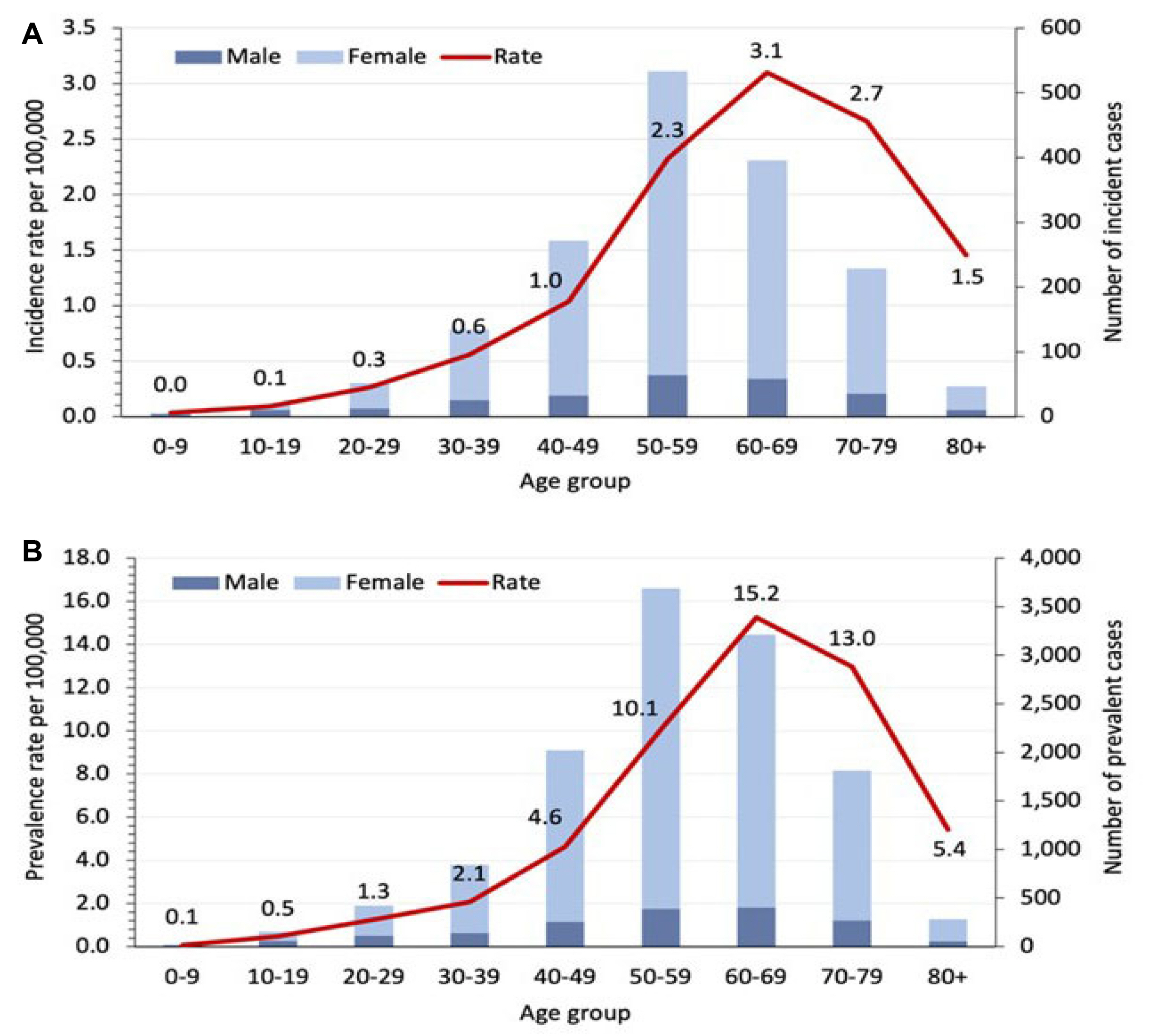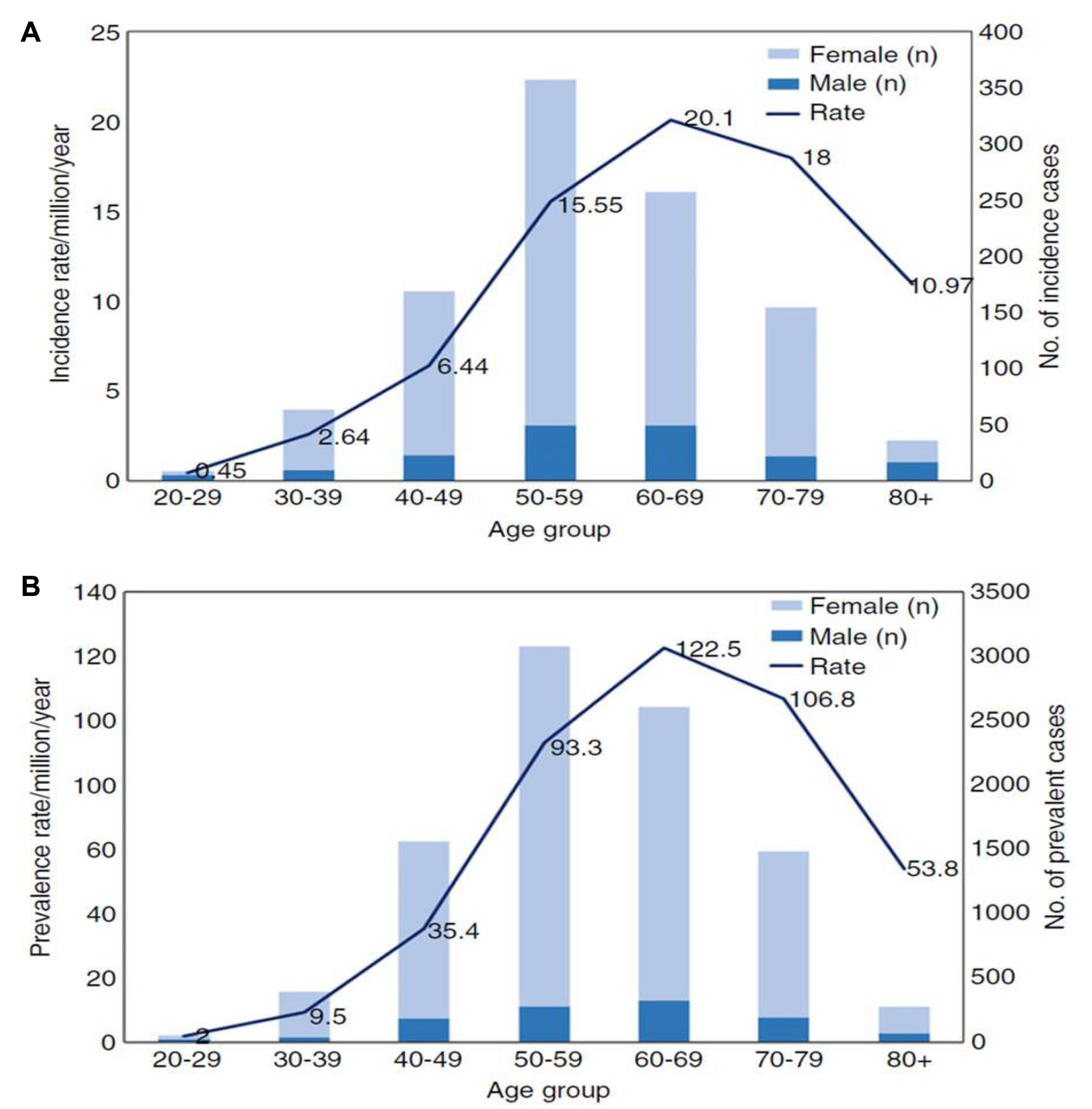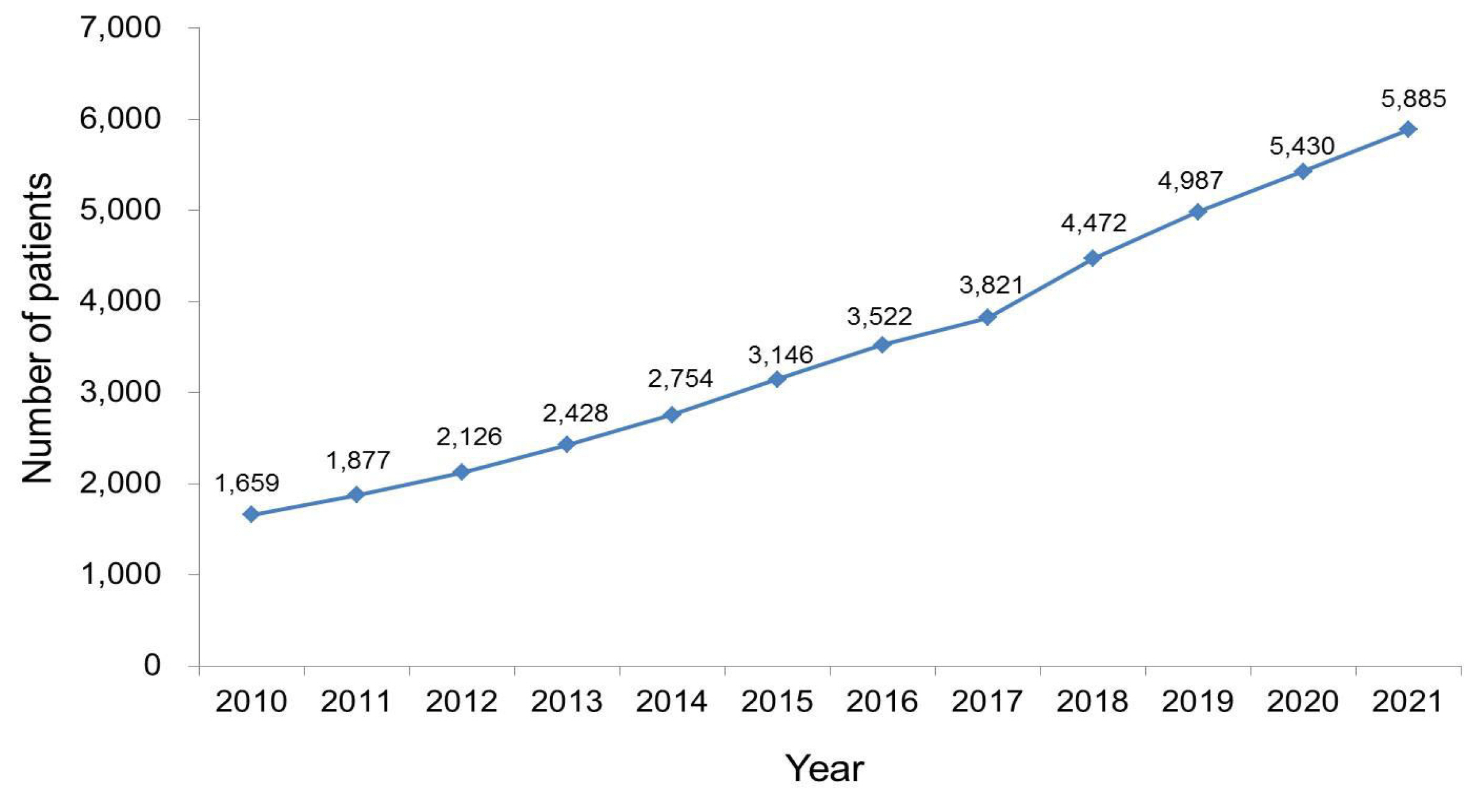Korean J Gastroenterol.
2023 Feb;81(2):59-65. 10.4166/kjg.2023.007.
Epidemiology of Autoimmune Liver Disease
- Affiliations
-
- 1Department of Internal Medicine, Inje University Haeundae Paik Hospital, Inje University College of Medicine, Busan, Korea
- KMID: 2539574
- DOI: http://doi.org/10.4166/kjg.2023.007
Abstract
- Autoimmune liver disease is an important immune-mediated pathologic entity involving the liver and intrahepatic bile duct, including autoimmune hepatitis, primary biliary cholangitis, and primary sclerosing cholangitis. Although it is necessary to ascertain its presence in acute or chronic liver disease without common causes, it is not easy to diagnose this disease straightforwardly because of its rarity. Recently, the incidence and prevalence of autoimmune hepatitis and primary biliary cholangitis have increased in several regions. In contrast, there is limited data dealing with the trend of the epidemiology of primary sclerosing cholangitis worldwide. Physicians should consider the epidemiologic characteristics of autoimmune liver disease because early diagnosis and proper treatment might prevent the progression of advanced liver disease. In addition, more sophisticated epidemiologic studies will be needed to elucidate the trend of these rare diseases nationwide.
Keyword
Figure
Reference
-
1. Kim BH, Kim YJ, Jeong SH, et al. 2013; Clinical features of autoimmune hepatitis and comparison of two diagnostic criteria in Korea: a nationwide, multicenter study. J Gastroenterol Hepatol. 28:128–134. DOI: 10.1111/j.1440-1746.2012.07292.x. PMID: 23033899.
Article2. Kim BH, Choi HY, Ki M, Kim KA, Jang ES, Jeong SH. 2017; Populationbased prevalence, incidence, and disease burden of autoimmune hepatitis in South Korea. PLoS One. 12:e0182391. DOI: 10.1371/journal.pone.0182391. PMID: 28771543. PMCID: PMC5542613.
Article3. Lv T, Li M, Zeng N, et al. 2019; Systematic review and meta-analysis on the incidence and prevalence of autoimmune hepatitis in Asian, European, and American population. J Gastroenterol Hepatol. 34:1676–1684. DOI: 10.1111/jgh.14746. PMID: 31146297.
Article4. Grønbæk L, Vilstrup H, Jepsen P. 2014; Autoimmune hepatitis in Denmark: incidence, prevalence, prognosis, and causes of death. A nationwide registry-based cohort study. J Hepatol. 60:612–617. DOI: 10.1016/j.jhep.2013.10.020. PMID: 24326217.
Article5. Danielsson Borssén Å, Marschall HU, Bergquist A, et al. 2017; Epidemiology and causes of death in a Swedish cohort of patients with autoimmune hepatitis. Scand J Gastroenterol. 52:1022–1028. DOI: 10.1080/00365521.2017.1335772. PMID: 28562110.
Article6. Lamba M, Ngu JH, Stedman CAM. 2021; Trends in incidence of autoimmune liver diseases and increasing incidence of autoimmune hepatitis. Clin Gastroenterol Hepatol. 19:573–579.e1. DOI: 10.1016/j.cgh.2020.05.061. PMID: 32526342.
Article7. Grønbaek L, Otete H, Ban L, et al. 2020; Incidence, prevalence and mortality of autoimmune hepatitis in England 1997-2015. A population-based cohort study. Liver Int. 40:1634–1644. DOI: 10.1111/liv.14480. PMID: 32304617.
Article8. Yoshizawa K, Joshita S, Matsumoto A, et al. 2016; Incidence and prevalence of autoimmune hepatitis in the Ueda area, Japan. Hepatol Res. 46:878–883. DOI: 10.1111/hepr.12639. PMID: 26670542.
Article9. Tunio NA, Mansoor E, Sheriff MZ, Cooper GS, Sclair SN, Cohen SM. Epidemiology of autoimmune hepatitis (AIH) in the United States between 2014 and 2019: A Population-based National Study. J Clin Gastroenterol. 2021; 55:903–910. DOI: 10.1097/MCG.0000000000001449. PMID: 33074948. PMCID: PMC8050120.
Article10. Lv T, Chen S, Li M, Zhang D, Kong Y, Jia J. 2021; Regional variation and temporal trend of primary biliary cholangitis epidemiology: A systematic review and meta-analysis. J Gastroenterol Hepatol. 36:1423–1434. DOI: 10.1111/jgh.15329. PMID: 33141955.
Article11. Kim KA, Ki M, Choi HY, Kim BH, Jang ES, Jeong SH. 2016; Populationbased epidemiology of primary biliary cirrhosis in South Korea. Aliment Pharmacol Ther. 43:154–162. DOI: 10.1111/apt.13448. PMID: 26526639.
Article12. Mehta TI, Weissman S, Fung BM, Sotiriadis J, Lindor KD, Tabibian JH. 2021; Global incidence, prevalence and features of primary sclerosing cholangitis: A systematic review and meta-analysis. Liver Int. 41:2418–2426. DOI: 10.1111/liv.15007. PMID: 34224208.
Article13. Trivedi PJ, Hirschfield GM. 2021; Recent advances in clinical practice: epidemiology of autoimmune liver diseases. Gut. 70:1989–2003. DOI: 10.1136/gutjnl-2020-322362. PMID: 34266966.
Article14. Barner-Rasmussen N, Pukkala E, Jussila A, Färkkilä M. 2020; Epidemiology, risk of malignancy and patient survival in primary sclerosing cholangitis: a population-based study in Finland. Scand J Gastroenterol. 55:74–81. DOI: 10.1080/00365521.2019.1707277. PMID: 31902255.
Article15. Tanaka A, Mori M, Matsumoto K, Ohira H, Tazuma S, Takikawa H. 2019; Increase trend in the prevalence and male-to-female ratio of primary biliary cholangitis, autoimmune hepatitis, and primary sclerosing cholangitis in Japan. Hepatol Res. 49:881–889. DOI: 10.1111/hepr.13342. PMID: 30932290.
Article16. Liang H, Manne S, Shick J, Lissoos T, Dolin P. 2017; Incidence, prevalence, and natural history of primary sclerosing cholangitis in the United Kingdom. Medicine (Baltimore). 96:e7116. DOI: 10.1097/MD.0000000000007116. PMID: 28614231. PMCID: PMC5478316.
Article17. Toy E, Balasubramanian S, Selmi C, Li CS, Bowlus CL. 2011; The prevalence, incidence and natural history of primary sclerosing cholangitis in an ethnically diverse population. BMC Gastroenterol. 11:83. DOI: 10.1186/1471-230X-11-83. PMID: 21767410. PMCID: PMC3160402.
Article18. Escorsell A, Parés A, Rodés J, Solís-Herruzo JA, Miras M, de la Morena E. 1994; Epidemiology of primary sclerosing cholangitis in Spain. Spanish Association for the Study of the Liver. J Hepatol. 21:787–791. DOI: 10.1016/S0168-8278(94)80240-8. PMID: 7890895.19. Boonstra K, Weersma RK, van Erpecum KJ, et al. EpiPSCPBC Study Group. Population-based epidemiology, malignancy risk, and outcome of primary sclerosing cholangitis. Hepatology. 2013; 58:2045–2055. EpiPSCPBC Study Group. DOI: 10.1002/hep.26565. PMID: 23775876.
Article20. Tansel A, Katz LH, El-Serag HB, et al. 2017; Incidence and determinants of hepatocellular carcinoma in autoimmune hepatitis: A systematic review and meta-analysis. Clin Gastroenterol Hepatol. 15:1207–1217.e4. DOI: 10.1016/j.cgh.2017.02.006. PMID: 28215616. PMCID: PMC5522646.
Article21. Mack CL, Adams D, Assis DN, et al. 2020; Diagnosis and management of autoimmune hepatitis in adults and children: 2019 Practice Guidance and Guidelines From the American Association for the Study of Liver Diseases. Hepatology. 72:671–722. DOI: 10.1002/hep.31065. PMID: 31863477.
Article22. Liang Y, Yang Z, Zhong R. 2012; Primary biliary cirrhosis and cancer risk: a systematic review and meta-analysis. Hepatology. 56:1409–1417. DOI: 10.1002/hep.25788. PMID: 22504852.
Article23. Trivedi PJ, Lammers WJ, van Buuren HR, et al. Global PBC Study Group. Stratification of hepatocellular carcinoma risk in primary biliary cirrhosis: a multicentre international study. Gut. 2016; 65:321–329. DOI: 10.1136/gutjnl-2014-308351. PMID: 25567117.
Article24. European Association for the Study of the Liver. 2017; EASL Clinical Practice Guidelines: The diagnosis and management of patients with primary biliary cholangitis. J Hepatol. 67:145–172. DOI: 10.1016/j.jhep.2017.03.022. PMID: 28427765.25. Choi J, Ghoz HM, Peeraphatdit T, et al. 2016; Aspirin use and the risk of cholangiocarcinoma. Hepatology. 64:785–796. DOI: 10.1002/hep.28529. PMID: 26940227. PMCID: PMC5995727.
Article26. Karlsen TH, Folseraas T, Thorburn D, Vesterhus M. 2017; Primary sclerosing cholangitis - a comprehensive review. J Hepatol. 67:1298–1323. DOI: 10.1016/j.jhep.2017.07.022. PMID: 28802875.
Article27. European Association for the Study of the Liver. 2009; EASL Clinical Practice Guidelines: management of cholestatic liver diseases. J Hepatol. 51:237–267. DOI: 10.1016/j.jhep.2009.04.009. PMID: 19501929.
- Full Text Links
- Actions
-
Cited
- CITED
-
- Close
- Share
- Similar articles
-
- Cyclosporine Treatment in a Patient with Concurrent Autoimmune Urticaria and Autoimmune Hepatitis
- A Case of Autoimmune Hepatitis
- Epidemiology and updated management for autoimmune liver disease
- Transient elastography for assessing liver fibrosis in autoimmune liver diseases: Excellent performance but limited details: Editorial on “Diagnostic accuracy of vibration-controlled transient elastography for staging liver fibrosis in autoimmune liver diseases: A systematic review and meta-analysis”
- A Case of Overlap Syndromebetween Autoimmune Hepatitis and Primary Biliary Cirrhosis





